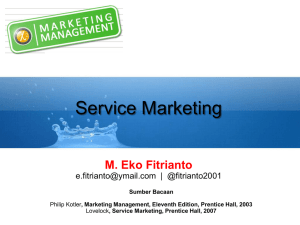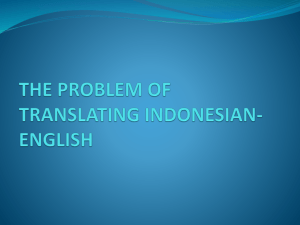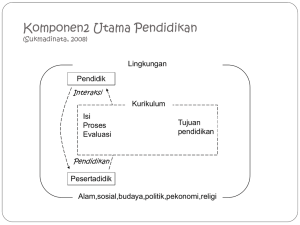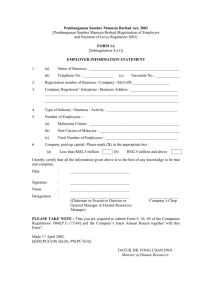Melakukan dan MEMPUBLIKASIKAN HASIL PENELITIAN
advertisement
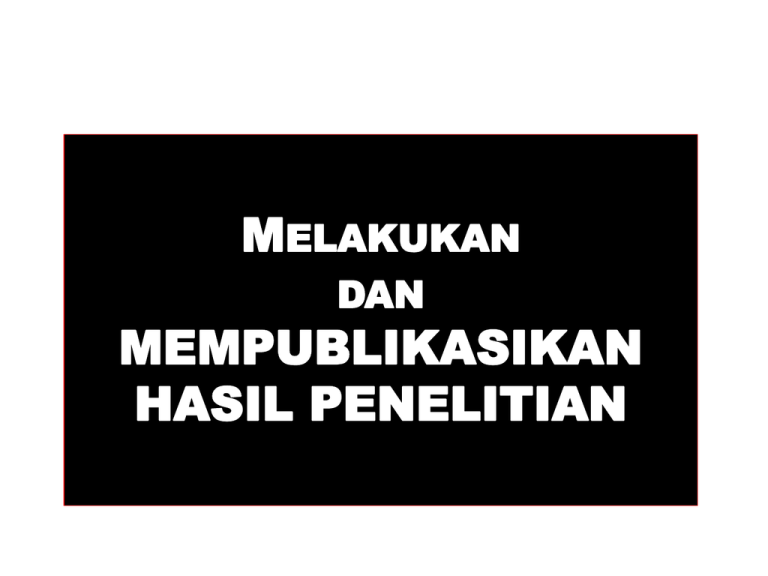
MELAKUKAN DAN MEMPUBLIKASIKAN HASIL PENELITIAN MELAKUKAN & MEMPUBLIKASIKAN Desain penelitian → bangunan hipotesis yang tepat → tidak berlebihan relevansinya (misal, untuk lembaga pendanaan) → membatasi efek bias bawah sadar (studi double blind ...) kekayaan intelektual → Ilmu adalah perdagangan sosial → hadiah bagi seorang ilmuwan adalah reputasi yang dihasilkan dari pekerjaannya → Untuk itu: perlu memberi pengakuan! → pekerjaan yang Anda membangun sebelumnya, ide / hipotesa yang Anda ikuti, metode yang dikembangkan oleh orang lain MELAKUKAN & MEMPUBLIKASIKAN Pembicaran informal dalam suatu pertemuan ilmiah ... Pada konferensi ilmiah, seorang ilmuwan terkenal memberikan presentasi review hasil penelitian. Dia pada dasarnya menyajikan karyanya sendiri. Dalam diskusi, seorang peserta menyebutkan bahwa hasil sejenis telah ditemukan oleh kelompok lain dan bahwa Konsep utama yang digunakan dalam karyanya telah dirumuskan oleh peneliti lain. Pembicara tersenyum lebar dan menjawab: "Yah, perlu anda tahu, aku tidak terlalu pandai memberikan penghargaan ..." MELAKUKAN & MEMPUBLIKASIKAN rencana pelaksanaan Penelitian → akurasi dan pengawasan dalam pengumpulan data → pemilihan data untuk analisis ("outlier"??) → retensi data dan catatan setelah analisis Contoh dari praktek-praktek analisis data dipertanyakan: 1. Mengabaikan kesalahan nonrandom (bias) 2. Post hoc hipotesis 3. Berbagai pembandingan dan pemanfaatan data dari bergai analisis 4. Pengujian statistik yang tidak tepat atau prosedur statistik lainnya 5. Kesimpulan "negatif" dengan metode statistik yang kurang tepat 6. Memadatkan, penghilangkan, "menyesuaikan" data MELAKUKAN & MEMPUBLIKASIKAN kesalahan yang Jujur vs kesalahan kelalaian vs kesalahan → kadang sulit untuk membedakan, "zona abu-abu" A. van Maanen dan kontroversi nebular (~ 1920) → kesalahan yang jujur , tetapi tidak menyadari bias oleh keyakinan yang kuat? Polywater (1960) → rancangan eksperimental yang lemah Schön kasus → fabrikasi, kesalahan prosedur MELAKUKAN & MEMPUBLIKASIKAN Komunikasi lIsan (Oral): 1. Diskusi, seminar, konferensi, poster 2. Memberikan pengakuan: kolaborator, sumber ide, hipotesis, ... 3. Pesan utama →, rincian sering tidak diberi (keterbatasan waktu) 4. Berfungsi untuk mengumumkan hasil sebelum publikasi, atau membuat orang sadar akan pekerjaan yang telah diterbitkan MELAKUKAN & MEMPUBLIKASIKAN Komunikasi secara Ditulis / presentasi (dalam jurnal peer-review) 1. 2. 3. 4. 5. Penting sebagai media komunikasi ilmiah Meninjau kekhawatiran akurasi ilmiah & relevansi dari pekerjaan Kemungkinan konflik kepentingan pada sisi resensi Setelah publikasi: menyediakan data mendasar atau permintaan? Bagaimana jika hasil yang dipublikasikan terbukti secara teknis salah? pencabutan? erratum? 6. Presentasi kepada masyarakat umum MELAKUKAN & MEMPUBLIKASIKAN Penulis (Authosrhip): 1. Penting: mengalokasikan penghargaan bagi kontributor, langkah-langkah pencapaian, 2. hasil PENELITIAN merupakan tanggung jawab bersama 3. Plagiat? LPU: "unit yang paling patut diterbitkan “ MELAKUKAN & MEMPUBLIKASIKAN Siapa yang harus sebagai autor? 1. Kontributor utama secara intelektual dari publikasi adalah keduanya baik diperlukan dan memenuhi syarat sebagai penulis 2. "Setiap penulis harus dapat mengambil tanggung jawab publik untuk isi publikasi, harus mampu menjelaskan mengapa dan bagaimana observasi (analisis matematika, simulasi ...) dilakukan, dan bagaimana kesimpulan sesuai dnegan data (hasil). “ 3. Lainnya, lebih terbatas, kontribusi dalam "Penghargaan “ 4. "Penulis kehormatan " BUKAN” praktek ilmiah yang baik MELAKUKAN & MEMPUBLIKASIKAN Kehormatan penulis, mengapa tidak? pembaca bisa tersesat tentang kualitas / kepadatan dari tulisan memiliki rekan penulis yang tidak menghasilkan penelitian tetapi memliki reputasi besar Reputasi → penulis pertama meningkat atas biaya orang lain yang tidak memiliki nama besar dalam daftar mereka Penulis → kehormatan menerima penghargaaan tidak layak Instrumen orang yang bertanggung jawab pada analisis data tanpa kontribusi? → reputasi ilmiah sebagai prestasi manajerial? → kontribusi dari anggota tim lainnya? → membedakan antara tim "sendiri“ dan pihak luar MELAKUKAN & MEMPUBLIKASIKAN Urutan Authorship (Penulis): 1. Banyak penulis ("... et al. “), tetapi tidak ada praktek yang unik 2. Urutan → tidak boleh menyembunyikan kebenaran "penulis pertama“ 3. Kemungkinan →: abjad, kecuali kontribusi tersebut tidak sama, kelompok mungkin permutate ketertiban, info tentang kontribusi dalam catatan kaki 4. “Efek Matius“ 5. Menginformasikan diri sendiri, membahas aturan penulisan dalam kelompok! 6. Tidak menerima hirarki, autorita penyelenggaraan…... (hal ini lebih mudah dikatakan daripada dilakukan) MELAKUKAN & MEMPUBLIKASIKAN Tanggung Jawab penulis: 1. Mereview naskah, merevisi naskah dll. 2. Menjamin bahwa prosedur yang tepat telah diikuti 3. Memastikan bahwa pengakuan telah diberikan, kerja yang relevan dikutip (termasuk juga bekerja tidak diterbitkan, misalnya presentasi oral, poster, atau diskusi komentar di pertemuan) Apakah “research” itu? Generally defined as “studious inquiry or examination aimed at the discovery and interpretation of facts, revision of accepted theories or laws in the light of new facts, or practical application of such new or revised theories or laws.” Sumber: www.mrc.uidaho.edu/.../Ethics%20workshop/Ethics... Apakah Publikasi itu? • Penyebar-luasan hasil-hasil penelitian ilmiah kepada komunitas ilmiah • Publikasi ilmiah harus tunduk pada “peer review” 14 Sumber: www.mrc.uidaho.edu/.../Ethics%20workshop/Ethics... Apakah problem etika yang mungkin terjadi dalam penelitian dan publikasi ilmiah? 1. You’ve just done a comprehensive experiment with 100 test cases 2. 99 of those test cases went just like your theory said they would 3. 1 case did not, and you don’t know why. You think the sample might have been contaminated 4. Do you report that 1 case or not? 15 Sumber: www.mrc.uidaho.edu/.../Ethics%20workshop/Ethics... Apakah problem etika yang mungkin terjadi dalam penelitian dan publikasi ilmiah? 1. You’re the acknowledged leading expert in your field and have been for 15 years. 2. The theory you discovered 15 years ago has made you famous and respected, and brought enormous prestige to your university. 3. You hear you’re being nominated for the Nobel Prize for your life’s work 4. You’ve just gotten the data in from your latest experiment and guess what: Your famous theory is dead wrong. 5. What now? 16 Sumber: www.mrc.uidaho.edu/.../Ethics%20workshop/Ethics... Dale J. Benos, Jorge Fabres, John Farmer, et al Ethics and scientific publication// Adv Physiol Educ 29: 59–74, 2005 Publikasi Ilmiah Publikasi hasil penelitian merupakan bagian integral dan esensial dari suatu penelitian. Semua peneliti berkewajiban mempublikasikan hasil-hasil penelitiannya secara proporsional. Flow diagram of review and publication process for a manuscript submitted to a journal Sumber: www.pitt.edu/~super7/48011-49001/48281.ppt Apa saja yang dapat dipublikasikan ? …. Jurnal ingin & senang mempublikasikan makalah yang akan banyak dibaca dan bermanfaat bagi para pembaca: 1. Paper yang melaporkan temuan-temuan “original dan significant” yang menarik minat para pembacanya 2. Papers that are well organized and well written, with clear statements regarding how the findings relate to and advance the understanding/development of the subject 3. Papers that are concise and yet complete in their presentation of the findings Sumber: www.pitt.edu/~super7/48011-49001/48281.ppt Distribusi Isu-isu etika dalam American Physiological Society publications (1996 - Maret 2004) Dale J. Benos, Jorge Fabres, John Farmer, et al Ethics and scientific publication// Adv Physiol Educ 29: Sumber: www.pitt.edu/~super7/48011-49001/48281.ppt 59–74, 2005 Problem: Penulis dan Kontributor An “author” is generally considered to be someone who has made substantive intellectual contributions to a published study, and biomedical authorship continues to have important academic, social, and financial implications . Authorship credit should be based on : 1. Substantial contributions to conception and design, acquisition of data, or analysis and interpretation of data; 2. Drafting the article or revising it critically for important intellectual content; and 3. Final approval of the version to be published. Authors should meet conditions 1, 2, and 3. Sumber: www.pitt.edu/~super7/48011-49001/48281.ppt Authorship = Penulis = Pengarang 1. guest authors are those who do not meet accepted authorship criteria but are listed because of their seniority, reputation or supposed influence 2. gift authors are those who do not meet accepted authorship criteria but are listed as a personal favour or in return for payment 3. ghost authors are those who meet authorship criteria but are not listed Sumber: www.pitt.edu/~super7/48011-49001/48281.ppt Contributors Listed in Acknowledgments • • • All contributors who do not meet the criteria for authorship should be listed in an acknowledgments section. Editors should ask corresponding authors to declare whether they had assistance with study design, data collection, data analysis, or manuscript preparation. If such assistance was available, the authors should disclose the identity of the individuals who provided this assistance and the entity that supported it in the published article. Financial and material support should also be acknowledged. Groups of persons who have contributed materially to the paper but whose contributions do not justify authorship may be listed under such headings as “clinical investigators” or “participating investigators,” and their function or contribution should be described—for example, “served as scientific advisors,” “critically reviewed the study proposal,” “collected data,” or “provided and cared for study patients.” Because readers may infer their endorsement of the data and conclusions, these persons must give written permission to be acknowledged. Sumber: www.pitt.edu/~super7/48011-49001/48281.ppt Sample authorship description/acknowledgement Drs A, B and C designed and conducted the study, including patient recruitment, data collection, and data analysis. Dr A prepared the manuscript draft with important intellectual input from Drs B and C. All authors approved the final manuscript. [Insert name of organization] provided funding for the study, statistical support in analyzing the data with input from Drs A, B and C, and also provided funding for editorial support. Drs A, B and C had complete access to the study data. We would like to thank Dr D for her editorial support during preparation of this manuscript. Sumber: www.pitt.edu/~super7/48011-49001/48281.ppt Accountability and responsibility • • • • • • All authors should have read and be familiar with the reported work and should ensure that publications follow the principles set out in these guidelines. In most cases, authors will be expected to take joint responsibility for the integrity of the research and its reporting. However, if authors take responsibility only for certain aspects of the research and its reporting, this should be specified in the publication. Authors should work with the editor or publisher to correct their work promptly if errors or omissions are discovered after publication. Authors should abide by relevant conventions, requirements, and regulations to make materials, reagents, software or datasets available to other researchers who request them. Researchers, institutions, and funders should have clear policies for handling such requests. Authors must also follow relevant journal standards. While proper acknowledgement is expected, researchers should not demand authorship as a condition for sharing materials. Authors should respond appropriately to post-publication comments and published correspondence. They should attempt to answer correspondents’ questions and supply clarification or additional details where needed. Sumber: www.pitt.edu/~super7/48011-49001/48281.ppt Soundness and reliability • The research being reported should have been conducted in an ethical and responsible manner and follow all relevant legislation. • The research being reported should be sound and carefully executed. • Researchers should use appropriate methods of data analysis and display (and, if needed, seek and follow specialist advice on this). • Authors should take collective responsibility for their work and for the content of their publications. Researchers should check their publications carefully at all stages to ensure methods and findings are reported accurately. • Authors should carefully check calculations, data presentations, typescripts/submissions and proofs. Sumber: www.pitt.edu/~super7/48011-49001/48281.ppt Definisi yang Bermakna: Mal-praktek Ilmiah “Scientific misconduct means fabrication, falsification, plagiarism, or other practices that seriously deviate from those that are commonly accepted within the scientific community for proposing, conducting or reporting research” Managing Allegations of Scientific Misconduct: A Guidance Document for Editors, January 2000, Office of Research Integrity, Office of Public Health and Science, U.S. Dept. of Health and Human Services http://ori.dhhs.gov Sumber: www.pitt.edu/~super7/48011-49001/48281.ppt Definisi yang Bermakna: Mal-praktek Ilmiah Plagiarism: using the ideas or words of another person without giving appropriate credit (Nat. Acad. Press document) Self-Plagiarism: The verbatim copying or reuse of one’s own research (IEEE Policy statement) Both types of plagiarism are considered to be unacceptable practice by most scientific publications Sumber: www.pitt.edu/~super7/48011-49001/48281.ppt Honesty = Kejujuran Ilmiah 1. Researchers should present their results honestly and without fabrication, falsification or inappropriate data manipulation. Research images (e.g. micrographs, X-rays, pictures of electrophoresis gels) should not be modified in a misleading way. 2. Researchers should strive to describe their methods and to present their findings clearly and unambiguously. Researchers should follow applicable reporting guidelines. Publications should provide sufficient detail to permit experiments to be repeated by other researchers. 3. Reports of research should be complete. They should not omit inconvenient, inconsistent or inexplicable findings or results that do not support the authors’ or sponsors’ hypothesis or interpretation. Sumber: www.pitt.edu/~super7/48011-49001/48281.ppt Honesty = Kejujuran Ilmiah 4. Research funders and sponsors should not be able to veto publication of findings that do not favour their product or position. Researchers should not enter agreements that permit the research sponsor to veto or control the publication of the findings (unless there are exceptional circumstances, such as research classified by governments because of security implications). 5. Authors should alert the editor promptly if they discover an error in any submitted, accepted or published work. Authors should cooperate with editors in issuing corrections or retractions when required. 6. Authors should represent the work of others accurately in citations and quotations. 7. Authors should not copy references from other publications if they have not read the cited work. Sumber: www.pitt.edu/~super7/48011-49001/48281.ppt Intellectual Property: Plagiarism, Copyright and Intellectual property A definition of plagiarism from the Office of Research Integrity: Plagiarism includes both the theft or misappropriation of intellectual property and the substantial unattributed textual copying of another's work. It does not include authorship or credit disputes. The theft or misappropriation of intellectual property includes the unauthorized use of ideas or unique methods obtained by a privileged communication, such as a grant or manuscript review. All Authors are required to grant editors an exclusive publishing license before their work can be published. This license also contains the warranty that the work is the author’s original work. Sumber: www.pitt.edu/~super7/48011-49001/48281.ppt Credit • Citing sources of information and ideas (also aids credibility, helps in finding out more) • Avoiding excessive use of others’ words – Recording sources when copying items or taking notes – Placing in quotation marks, or indenting, items used verbatim – Perhaps drafting some items while not looking at the source materials – Observing copyright and obtaining needed permissions Sumber: www.pitt.edu/~super7/48011-49001/48281.ppt Tipe-tipe lainnya Pelanggaran Etika 1. Duplicate publication/submission of research findings; failure to inform the editor of related papers that the author has under consideration or “in press” 2. Unrevealed conflicts of interest that could affect the interpretation of the findings 3. Misrepresentation of research findings - use of selective or fraudulent data to support a hypothesis or claim Sumber: www.pitt.edu/~super7/48011-49001/48281.ppt Originality • Not republishing the same findings (except under special circumstances, with the original source cited) • Not submitting the same manuscript to two or more journals at once • Not dividing one research project into many little papers (“salami science”) Sumber: www.pitt.edu/~super7/48011-49001/48281.ppt Balance New findings should be presented in the context of previous research. The work of others should be fairly represented. Scholarly reviews and syntheses of existing research should be complete, balanced, and should include findings regardless of whether they support the hypothesis or interpretation being proposed. Editorials or opinion pieces presenting a single viewpoint or argument should be clearly distinguished from scholarly reviews. Study limitations should be addressed in publications. Sumber: www.pitt.edu/~super7/48011-49001/48281.ppt Transparency • All sources of research funding, including direct and indirect financial support, supply of equipment or materials, and other support (such as specialist statistical or writing assistance) should be disclosed. • Authors should disclose the role of the research funder(s) or sponsor (if any) in the research design, execution, analysis, interpretation and reporting. • Authors should disclose relevant financial and non-financial interests and relationships that might be considered likely to affect the interpretation of their findings or which editors, reviewers or readers might reasonably wish to know. This includes any relationship to the journal, for example if editors publish their own research in their own journal. In addition, authors should follow journal and institutional requirements for disclosing competing interests. Sumber: www.pitt.edu/~super7/48011-49001/48281.ppt Kepatuhan terhadap peer review dan konvensi publikasi 1. 2. 3. 4. 5. Authors should follow publishers’ requirements that work is not submitted to more than one publication for consideration at the same time. Authors should inform the editor if they withdraw their work from review, or choose not to respond to reviewer comments after receiving a conditional acceptance. Authors should respond to reviewers’ comments in a professional and timely manner. Authors should respect publishers’ requests for press embargos and should not generally allow their findings to be reported in the press if they have been accepted for publication (but not yet published) in a scholarly publication. Authors and their institutions should liaise and cooperate with publishers to coordinate media activity (e.g. press releases and press conferences) around publication. Press releases should accurately reflect the work and should not include statements that go further than the research findings. Sumber: www.pitt.edu/~super7/48011-49001/48281.ppt Prinsip Etika: Penelitian ttg Manusia dan Hewan 1. For experiments involving human subjects, the committee approving the experiments should be identified and the research conducted according to the principles expressed in the Declaration of Helsinki). 2. The Authors should confirm that informed consent was obtained from all subjects. 3. Appropriate approval, licensing or registration should be obtained before the research begins and details should be provided in the report (e.g. Institutional Review Board, Research Ethics Committee approval, national licensing authorities for the use of animals) 4. Treatment must confirm to accepted international standards. 5. Manuscript must document that the study was approved by an ethical review board before it was done. 6. Note: Research on humans tends to be broadly defined, for example to include survey research. Sumber: www.pitt.edu/~super7/48011-49001/48281.ppt Tanggung-jawab Etika dari Editor dan Reviewer 1. Menjaga kerahasiaan 2. Tidak menyalahgunakan ide atau teks 3. Memberikan ulasan yang dibenarkan dan tanpa bias 4. Menyampaikan informasi kepada penulis secara tepat waktu 5. Mengungkapkan adanya konflik kepentingan Sumber: www.pitt.edu/~super7/48011-49001/48281.ppt Peer Review 1. Unbiased, independent, critical assessment is an intrinsic part of all scholarly work, including the scientific process. 2. Peer review is the critical assessment of manuscripts submitted to journals by experts who are not part of the editorial staff. 3. Peer review can therefore be viewed as an important extension of the scientific process. Peer review helps editors decide which manuscripts are suitable for their journals and helps authors and editors to improve the quality of reporting. A peer-reviewed journal submits most of its published research articles for outside review. The number and kinds of manuscripts sent for review, the number of reviewers, the reviewing procedures, and the use made of the reviewers’ opinions may vary. 4. Sumber: www.pitt.edu/~super7/48011-49001/48281.ppt Konflik Kepentingan Editors, authors, and peer reviewers have a responsibility to disclose interests that might appear to affect their ability to present or review data objectively. These include relevant financial (for example patent ownership, stock ownership, consultancies, speaker's fees), personal, political, intellectual, or religious interests. Can involve ◦ Editors ◦ Peer reviewers ◦ Authors Can be ◦ Financial ◦ Ideological ◦ Other Sumber: www.pitt.edu/~super7/48011-49001/48281.ppt Ringkasan 1. Penelitian yang dilaporkan seharusnya dilakukan secara etis dan bertanggung jawab dan harus mematuhi semua ketentuan yang relevan. 2. Peneliti harus menyajikan hasil oenelitiannya dengan jelas, jujur, dan tanpa fabrikasi, pemalsuan atau tidak manipulasi data. 3. Peneliti harus berusaha untuk menjelaskan metode penelitiannya secara jelas dan tegas sehingga temuannya dapat dikonfirmasikan oleh orang lain. 4. Peneliti harus mematuhi persyaratan publikasi yang memenuhi kerja asli (orisinal), tidak menjiplak, dan belum diterbitkan di tempat lain. 5. Penulis harus mengambil tanggung jawab kolektif untuk mengirim dan menerbitkan karya. 6. Kepengarangan publikasi penelitian harus secara akurat mencerminkan kontribusi individu untuk pekerjaan penelitian dan pelaporannya. 7. Sumber pendanaan dan konflik kepentingan yang relevan harus diungkapkan dan diselesaikan. Sumber: www.pitt.edu/~super7/48011-49001/48281.ppt Bgm Journals mendeteksi dan mengelola “Tulisan” yang bermasalah Information received from reviewers or other editors Literature search for related papers by the author Withdrawal of a paper from publication Banning authors from publication in the journal for 3-5 years and informing the co-authors and editors of related journals of our action For less serious cases, placing the author on a “watch list” for careful examination of their submissions prior to requesting review Sumber: www.pitt.edu/~super7/48011-49001/48281.ppt
